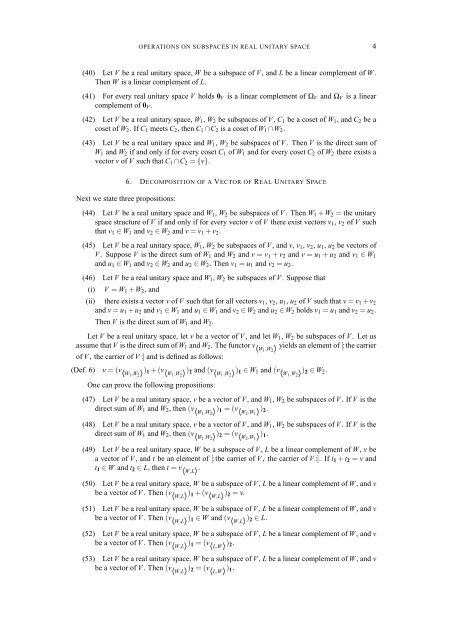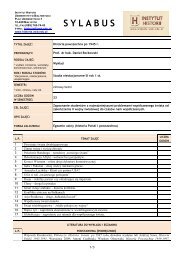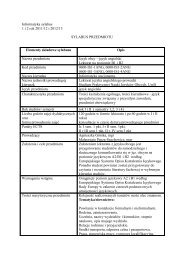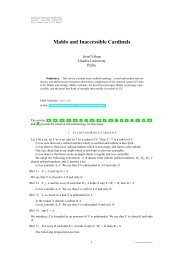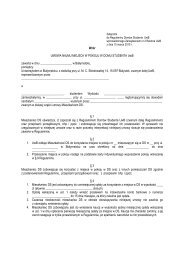Operations on Subspaces in Real Unitary Space
Contents - Markun Cs Shinshu U Ac Jp
Contents - Markun Cs Shinshu U Ac Jp
- No tags were found...
You also want an ePaper? Increase the reach of your titles
YUMPU automatically turns print PDFs into web optimized ePapers that Google loves.
OPERATIONS ON SUBSPACES IN REAL UNITARY SPACE 4<br />
(40) Let V be a real unitary space, W be a subspace of V , and L be a l<strong>in</strong>ear complement of W.<br />
Then W is a l<strong>in</strong>ear complement of L.<br />
(41) For every real unitary space V holds 0 V is a l<strong>in</strong>ear complement of Ω V and Ω V is a l<strong>in</strong>ear<br />
complement of 0 V .<br />
(42) Let V be a real unitary space, W 1 , W 2 be subspaces of V , C 1 be a coset of W 1 , and C 2 be a<br />
coset of W 2 . If C 1 meets C 2 , then C 1 ∩C 2 is a coset of W 1 ∩W 2 .<br />
(43) Let V be a real unitary space and W 1 , W 2 be subspaces of V . Then V is the direct sum of<br />
W 1 and W 2 if and <strong>on</strong>ly if for every coset C 1 of W 1 and for every coset C 2 of W 2 there exists a<br />
vector v of V such that C 1 ∩C 2 = {v}.<br />
6. DECOMPOSITION OF A VECTOR OF REAL UNITARY SPACE<br />
Next we state three propositi<strong>on</strong>s:<br />
(44) Let V be a real unitary space and W 1 , W 2 be subspaces of V . Then W 1 +W 2 = the unitary<br />
space structure of V if and <strong>on</strong>ly if for every vector v of V there exist vectors v 1 , v 2 of V such<br />
that v 1 ∈ W 1 and v 2 ∈ W 2 and v = v 1 + v 2 .<br />
(45) Let V be a real unitary space, W 1 , W 2 be subspaces of V , and v, v 1 , v 2 , u 1 , u 2 be vectors of<br />
V . Suppose V is the direct sum of W 1 and W 2 and v = v 1 + v 2 and v = u 1 + u 2 and v 1 ∈ W 1<br />
and u 1 ∈ W 1 and v 2 ∈ W 2 and u 2 ∈ W 2 . Then v 1 = u 1 and v 2 = u 2 .<br />
(46) Let V be a real unitary space and W 1 , W 2 be subspaces of V . Suppose that<br />
(i)<br />
V = W 1 +W 2 , and<br />
(ii) there exists a vector v of V such that for all vectors v 1 , v 2 , u 1 , u 2 of V such that v = v 1 + v 2<br />
and v = u 1 +u 2 and v 1 ∈ W 1 and u 1 ∈ W 1 and v 2 ∈ W 2 and u 2 ∈ W 2 holds v 1 = u 1 and v 2 = u 2 .<br />
Then V is the direct sum of W 1 and W 2 .<br />
Let V be a real unitary space, let v be a vector of V , and let W 1 , W 2 be subspaces of V . Let us<br />
assume that V is the direct sum of W 1 and W 2 . The functor v 〈W1 ,W 2 〉 yields an element of [:the carrier<br />
of V , the carrier of V :] and is def<strong>in</strong>ed as follows:<br />
(Def. 6) v = (v 〈W1 ,W 2 〉 ) 1 + (v 〈W1 ,W 2 〉 ) 2 and (v 〈W1 ,W 2 〉 ) 1 ∈ W 1 and (v 〈W1 ,W 2 〉 ) 2 ∈ W 2 .<br />
One can prove the follow<strong>in</strong>g propositi<strong>on</strong>s:<br />
(47) Let V be a real unitary space, v be a vector of V , and W 1 , W 2 be subspaces of V . If V is the<br />
direct sum of W 1 and W 2 , then (v 〈W1 ,W 2 〉 ) 1 = (v 〈W2 ,W 1 〉 ) 2.<br />
(48) Let V be a real unitary space, v be a vector of V , and W 1 , W 2 be subspaces of V . If V is the<br />
direct sum of W 1 and W 2 , then (v 〈W1 ,W 2 〉 ) 2 = (v 〈W2 ,W 1 〉 ) 1.<br />
(49) Let V be a real unitary space, W be a subspace of V , L be a l<strong>in</strong>ear complement of W, v be<br />
a vector of V , and t be an element of [:the carrier of V , the carrier of V :]. If t 1 + t 2 = v and<br />
t 1 ∈ W and t 2 ∈ L, then t = v 〈W,L〉 .<br />
(50) Let V be a real unitary space, W be a subspace of V , L be a l<strong>in</strong>ear complement of W, and v<br />
be a vector of V . Then (v 〈W,L〉 ) 1 + (v 〈W,L〉 ) 2 = v.<br />
(51) Let V be a real unitary space, W be a subspace of V , L be a l<strong>in</strong>ear complement of W, and v<br />
be a vector of V . Then (v 〈W,L〉 ) 1 ∈ W and (v 〈W,L〉 ) 2 ∈ L.<br />
(52) Let V be a real unitary space, W be a subspace of V , L be a l<strong>in</strong>ear complement of W, and v<br />
be a vector of V . Then (v 〈W,L〉 ) 1 = (v 〈L,W 〉 ) 2.<br />
(53) Let V be a real unitary space, W be a subspace of V , L be a l<strong>in</strong>ear complement of W, and v<br />
be a vector of V . Then (v 〈W,L〉 ) 2 = (v 〈L,W 〉 ) 1.


